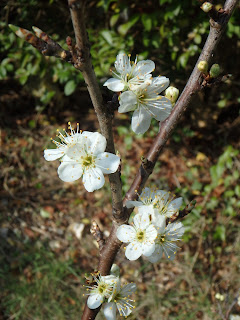This contrasted starkly with the walk last Sunday in the gloom - not raining at least. We had walked along the Stratford Reserve to the Avon Valley Nature Reserve on the outskirts of Salisbury. This is an area of SSSI owned by the Council. It's quite different to the Stratford Reserve - a wider floodplain, with managed tussocky grassland (managed by labour-intensive cutting and removal of cuttings), a wetland area, and a boardwalk along the riverbank.
But this Easter weekend started very differently - lots of lovely warm sunshine as we walked from Salisbury to Coombe Bissett for our pub lunch. The route takes us via the Racecourse and Ox Drove, for great views and many skylarks above us.
After lunch, we managed to haul ourselves on a slightly-longer route back, along the River Ebble (a highly valuable chalk stream), taking in the primroses and celandines, old boundary trees and watermeadow structures in the river. The route than crossed Stratford Tony and joined a Roman Road across arable fields. Here we encountered ancient trees and a surprising number of birds, including corn bunting (nationally rare), more skylarks and chiffchaffs. The latter are usually a summer migrant, although I believe a few are now starting to overwinter here. In any case, it was the first one of the season, which really heralds spring to me. Bring on the swifts and cuckoos!

And finally, I was just telling one of the people on the walk about the wonder of oil beetles, when only a few minutes down the path we encountered one crossing in front of us. They're pretty special in that they are nationally declining species, favouring unimproved grassland, which has been progressively lost throughout the decades. They also have a fascinating lifecycle, where the larvae have to attach themselves to the back of a solitary bee by climbing to the top of a flower stem. Arriving at the bee's burrow, the larvae then devour the bee's eggs and pollen stores, emerging as an adult usually in the spring (although some species emerge in the autumn). Amazing stuff, and an indicator of the health of an ecosystem - they have to have the right flowers for the bees to feed on, to enable the larvae to attach themselves and grow.















